Stella Atrium's Blog, page 2
June 12, 2022
The Logic of Men: Movie Review of The Last Duel
Based on a novel by Eric Jager about a real event, the last judgment-by-combat in French history in 1386, and directed by Ridley Scott, THE LAST DUEL scintillates with combat and armor and great horses. Each blow of the duel is felt by viewers.
.stk-90da6fc{margin-bottom:12px !important}@media screen and (min-width:768px){.stk-4f214ce{flex:1 1 calc(41.3% - var(--stk-column-gap,0px) * 1 / 2 ) !important}}.stk-0a33435 .stk-img-wrapper{width:56% !important;height:173px !important} @media screen and (min-width:768px){.stk-9c420cb{flex:1 1 calc(58.7% - var(--stk-column-gap,0px) * 1 / 2 ) !important}}
@media screen and (min-width:768px){.stk-9c420cb{flex:1 1 calc(58.7% - var(--stk-column-gap,0px) * 1 / 2 ) !important}}The Rashomon-style telling overcomplicates a straight-line plot. Illiterate and litigious Sir Jean de Carrouges (Matt Damon) has grudges against Squire Jacques le Gris (Adam Driver) but can gain no satisfaction from his drunken and degenerate liege lord Pierre d’Allecon (Ben Affleck) who claims that Carrouges is “no f—king fun.”
Players don’t even pretend at French accents, which is probably beyond Ben Affleck’s acting skills. Luckily, a female collaborator for the screenplay (Nicole Holofcener) provides some breathing space for Marguerite.
The usual male blind spots for directing are obvious. Marguerite de Carrouges (Jodie Comer) is the barren wife at the center of the lawsuit and excuse for a duel. Jodie Comer is 30 years younger than all the other players, and she looks like a foreign bride. What French woman has a thick braid of Nordic blonde hair?
**spoiler alert**
Le Gris spends one afternoon protesting to love Marguerite de Carrouges and forces himself on her while indulging some fantasy role in his mind. His giveaway is “if you run, I will only chase you,” a line he used in an earlier debauch.
.stk-d3b99a6{margin-bottom:12px !important}@media screen and (min-width:768px){.stk-fe36177{flex:1 1 calc(60.8% - var(--stk-column-gap,0px) * 1 / 2 ) !important}}Ladies, do these claims sound familiar?
I love you above all othersAll I want is for your happinessThe most exquisite fascinating womanI will save you from this harsh lifeI know you love me tooYou must, for I cannot help myselfGirl, when he starts talking like that, hang up the phone. Get off social media, locks the doors, gather the dogs, tell Alexa to record all sound in all rooms. Be certain the handgun in the bed stand is loaded.
@media screen and (min-width:768px){.stk-3febd49{flex:1 1 calc(39.2% - var(--stk-column-gap,0px) * 1 / 2 ) !important}}.stk-e30c973 .stk-img-wrapper{width:80% !important;height:318px !important}
Viewers of this movie are treated to two renditions of the rape, totally unneeded, and le Gris admonishes her to tell nobody, that her husband will most likely kill her. The threat demanding silence is all too familiar for any abused woman.
Marguerite lives an isolated life. A cruel mother-in-law who encourages the servants to report on her, fair-weather friends who give witness against her, farming peasants who have no opinion when she improves on her husband’s directives.
.stk-434fc91{margin-bottom:12px !important}@media screen and (min-width:768px){.stk-b35d547{flex:1 1 calc(42.9% - var(--stk-column-gap,0px) * 1 / 2 ) !important}}.stk-8ed693e .stk-img-wrapper{width:99% !important;height:257px !important} @media screen and (min-width:768px){.stk-5994968{flex:1 1 calc(57.1% - var(--stk-column-gap,0px) * 1 / 2 ) !important}}
@media screen and (min-width:768px){.stk-5994968{flex:1 1 calc(57.1% - var(--stk-column-gap,0px) * 1 / 2 ) !important}}She must navigate the logic of men alone.
Medicine is no help: “You have an imbalance of the four humours.”Science is no help: “It’s not rape if she enjoyed it. That’s just science.”The law is no help: “Rape is not a crime, but damage to the property of her male guardian.”And the church encourages le Gris to “take the benefit of clergy” who are exempt from civil law.With the deck stacked against her, Marguerite stands her ground to use the logic of men to her favor. She allows her husband to broadcast the story of her humiliation. His goal even from the beginning is to force a duel with his rival le Gris, as ordered by the king, turning to his “trust in god.” At least de Carrouges plays to his strength, a proven warrior while le Gris is a educated courtier and accountant.
Le Gris admits to the adultery but not the rape, drawing fine lines of distinction. “She made the usual protests, but then she’s a lady of the court.” He seeks advice from his liege lord Pierre d’Alencon prompting a moment when Ben Affleck interjects some decidedly modern tropes, very Clinton-esque. “The common mind has no capacity for this nuance. Deny, deny, deny.” Le Gris holds onto this advise until the moment a knife is thrust through his throat.
So Marguerite finally has her audience with the king before his court. The prosecutor uses the best of male logic. “Le Gris denies the incident, but if we entertain for the moment that you didn’t dream the story, then the incident (that he denies happened) cannot be rape because you enjoyed it as evidenced by your pregnancy.”
Men will say anything. And other men will nod like that makes sense.
.stk-ca6df17{margin-bottom:12px !important}@media screen and (min-width:768px){.stk-1d2e26e{flex:1 1 calc(50% - var(--stk-column-gap,0px) * 1 / 2 ) !important}}So they go forward with the duel after she bears the child. King Charles IV provides spectacle for the masses and appears to accede to god’s judgment.
If le Gris wins the combat, then the woman he professes to love, whose child may be his, will be burned at the stake. But his “honor” counts for more.
@media screen and (min-width:768px){.stk-1558f29{flex:1 1 calc(50% - var(--stk-column-gap,0px) * 1 / 2 ) !important}}.stk-8e409a7 .stk-img-wrapper{width:100% !important;height:222px !important}
De Carrouges does win the combat, so his name is cleared and his wife and child live, not that he cares about the heir. The knight is eager to bask in the triumph, though, even raising the bloody knife while they ride out of the arena.
.stk-8cc6af7{margin-bottom:8px !important}@media screen and (min-width:768px){.stk-e7b6038{flex:1 1 calc(38% - var(--stk-column-gap,0px) * 1 / 2 ) !important}}.stk-a49933c .stk-img-wrapper{width:59% !important;height:167px !important} @media screen and (min-width:768px){.stk-1f0de7e{flex:1 1 calc(62% - var(--stk-column-gap,0px) * 1 / 2 ) !important}}
@media screen and (min-width:768px){.stk-1f0de7e{flex:1 1 calc(62% - var(--stk-column-gap,0px) * 1 / 2 ) !important}}Marguerite rides behind. The crowd is not cheering for her. She has no avenue of redress, like Sec. of Labor Raymond Donovan under Pres. Reagan who was unjustly attacked by the press and famously asked, “Where do I go to get my reputation back?”
Marguerite de Carrouges wins by enduring. She inherits the estate and tracts of farmland when her husband later falls in the crusades, another useless and destructive expression of the logic of men.
The post The Logic of Men: Movie Review of The Last Duel first appeared on Stella Atrium.
The Logic of Men
Based on a novel by Eric Jager about a real event, the last judgment-by-combat in French history in 1386, and directed by Ridley Scott, THE LAST DUEL scintillates with combat and armor and great horses. Each blow of the duel is felt by viewers.
.stk-90da6fc{margin-bottom:12px !important}@media screen and (min-width:768px){.stk-4f214ce{flex:1 1 calc(41.3% - var(--stk-column-gap,0px) * 1 / 2 ) !important}}.stk-0a33435 .stk-img-wrapper{width:56% !important;height:173px !important} @media screen and (min-width:768px){.stk-9c420cb{flex:1 1 calc(58.7% - var(--stk-column-gap,0px) * 1 / 2 ) !important}}
@media screen and (min-width:768px){.stk-9c420cb{flex:1 1 calc(58.7% - var(--stk-column-gap,0px) * 1 / 2 ) !important}}The Rashomon-style telling overcomplicates a straight-line plot. Illiterate and litigious Sir Jean de Carrouges (Matt Damon) has grudges against Squire Jacques le Gris (Adam Driver) but can gain no satisfaction from his drunken and degenerate liege lord Pierre d’Allecon (Ben Affleck) who claims that Carrouges is “no f—king fun.”
Players don’t even pretend at French accents, which is probably beyond Ben Affleck’s acting skills. Luckily, a female collaborator for the screenplay (Nicole Holofcener) provides some breathing space for Marguerite.
The usual male blind spots for directing are obvious. Marguerite de Carrouges (Jodie Comer) is the barren wife at the center of the lawsuit and excuse for a duel. Jodie Comer is 30 years younger than all the other players, and she looks like a foreign bride. What French woman has a thick braid of Nordic blonde hair?
**spoiler alert**
Le Gris spends one afternoon protesting to love Marguerite de Carrouges and forces himself on her while indulging some fantasy role in his mind. His giveaway is “if you run, I will only chase you,” a line he used in an earlier debauch.
.stk-d3b99a6{margin-bottom:12px !important}@media screen and (min-width:768px){.stk-fe36177{flex:1 1 calc(60.8% - var(--stk-column-gap,0px) * 1 / 2 ) !important}}Ladies, do these claims sound familiar?
I love you above all othersAll I want is for your happinessThe most exquisite fascinating womanI will save you from this harsh lifeI know you love me tooYou must, for I cannot help myselfGirl, when he starts talking like that, hang up the phone. Get off social media, locks the doors, gather the dogs, tell Alexa to record all sound in all rooms. Be certain the handgun in the bed stand is loaded.
@media screen and (min-width:768px){.stk-3febd49{flex:1 1 calc(39.2% - var(--stk-column-gap,0px) * 1 / 2 ) !important}}.stk-e30c973 .stk-img-wrapper{width:80% !important;height:318px !important}
Viewers of this movie are treated to two renditions of the rape, totally unneeded, and le Gris admonishes her to tell nobody, that her husband will most likely kill her. The threat demanding silence is all too familiar for any abused woman.
Marguerite lives an isolated life. A cruel mother-in-law who encourages the servants to report on her, fair-weather friends who give witness against her, farming peasants who have no opinion when she improves on her husband’s directives.
.stk-434fc91{margin-bottom:12px !important}@media screen and (min-width:768px){.stk-b35d547{flex:1 1 calc(42.9% - var(--stk-column-gap,0px) * 1 / 2 ) !important}}.stk-8ed693e .stk-img-wrapper{width:99% !important;height:257px !important} @media screen and (min-width:768px){.stk-5994968{flex:1 1 calc(57.1% - var(--stk-column-gap,0px) * 1 / 2 ) !important}}
@media screen and (min-width:768px){.stk-5994968{flex:1 1 calc(57.1% - var(--stk-column-gap,0px) * 1 / 2 ) !important}}She must navigate the logic of men alone.
Medicine is no help: “You have an imbalance of the four humours.”Science is no help: “It’s not rape if she enjoyed it. That’s just science.”The law is no help: “Rape is not a crime, but damage to the property of her male guardian.”And the church encourages le Gris to “take the benefit of clergy” who are exempt from civil law.With the deck stacked against her, Marguerite stands her ground to use the logic of men to her favor. She allows her husband to broadcast the story of her humiliation. His goal even from the beginning is to force a duel with his rival le Gris, as ordered by the king, turning to his “trust in god.” At least de Carrouges plays to his strength, a proven warrior while le Gris is a educated courtier and accountant.
Le Gris admits to the adultery but not the rape, drawing fine lines of distinction. “She made the usual protests, but then she’s a lady of the court.” He seeks advice from his liege lord Pierre d’Alencon prompting a moment when Ben Affleck interjects some decidedly modern tropes, very Clinton-esque. “The common mind has no capacity for this nuance. Deny, deny, deny.” Le Gris holds onto this advise until the moment a knife is thrust through his throat.
So Marguerite finally has her audience with the king before his court. The prosecutor uses the best of male logic. “Le Gris denies the incident, but if we entertain for the moment that you didn’t dream the story, then the incident (that he denies happened) cannot be rape because you enjoyed it as evidenced by your pregnancy.”
Men will say anything. And other men will nod like that makes sense.
.stk-ca6df17{margin-bottom:12px !important}@media screen and (min-width:768px){.stk-1d2e26e{flex:1 1 calc(50% - var(--stk-column-gap,0px) * 1 / 2 ) !important}}So they go forward with the duel after she bears the child. King Charles IV provides spectacle for the masses and appears to accede to god’s judgment.
If le Gris wins the combat, then the woman he professes to love, whose child may be his, will be burned at the stake. But his “honor” counts for more.
@media screen and (min-width:768px){.stk-1558f29{flex:1 1 calc(50% - var(--stk-column-gap,0px) * 1 / 2 ) !important}}.stk-8e409a7 .stk-img-wrapper{width:100% !important;height:222px !important}
De Carrouges does win the combat, so his name is cleared and his wife and child live, not that he cares about the heir. The knight is eager to bask in the triumph, though, even raising the bloody knife while they ride out of the arena.
.stk-8cc6af7{margin-bottom:8px !important}@media screen and (min-width:768px){.stk-e7b6038{flex:1 1 calc(38% - var(--stk-column-gap,0px) * 1 / 2 ) !important}}.stk-a49933c .stk-img-wrapper{width:59% !important;height:167px !important} @media screen and (min-width:768px){.stk-1f0de7e{flex:1 1 calc(62% - var(--stk-column-gap,0px) * 1 / 2 ) !important}}
@media screen and (min-width:768px){.stk-1f0de7e{flex:1 1 calc(62% - var(--stk-column-gap,0px) * 1 / 2 ) !important}}Marguerite rides behind. The crowd is not cheering for her. She has no avenue of redress, like Sec. of Labor Raymond Donovan under Pres. Reagan who was unjustly attacked by the press and famously asked, “Where do I go to get my reputation back?”
Marguerite de Carrouges wins by enduring. She inherits the estate and tracts of farmland when her husband later falls in the crusades, another useless and destructive expression of the logic of men.
May 21, 2022
Four Tips for how YOU can stop the (local) Trafficking
Women and girls are at risk all over the world, including in your neighborhood. The rescue rate is often one rescuer for one victim. One rescuer for five victims is a good day. Here are four tips for awareness.
Be ObservantTo end the trafficking and abuse, advocates must raise awareness of the acts of perpetrators (nice word) and know how to recognize and address local situations. A woman or child may be in a foreign country to her and with few English words. She may avoid eye contact or cover bruises on her arms or legs. She will avoid notice by law enforcement officers.
Do not approach the victim. Take note of license plate numbers or street addresses. Do not be obvious while capturing a picture or video. A regular citizen is often not equipped to act in a volatile situation with a handler who is armed and motivated to keep his victim quiet.
If you see something, say something. The Chicago Children’s Advocacy Center has a hotline for an observant resident to call when witnessing endangerment of a child.
If you suspect or know that a child (someone 17 or younger) is being trafficked, call the Illinois DCFS Child Abuse Hotline: 1-800-25-ABUSE (1-800-252-2873). If a child is in immediate danger, also call 911.
Human Trafficking PreventionDonate locally
What happens to the victim after rescue? She has no support from family, no resources, no education. She often returns to prostitution because that’s all she knows. Rescue includes extended responsibility for that person, often within a network of women.
Groups in the local community are where we can see our charity dollars at work. In the Chicagoland area, please think about donating to:
Pacific Garden Missions that shelters and feeds the homeless
Covenant House has specialized in LGBTQ+ runaways
https://www.covenanthouse.org/homeless-shelters/chicago-illinois
Genesis House for Women and Girls that provides safe housing for victims of abuse and their children
DonateAct Globally
To address root causes, we must act at the village level for the women and girls at risk. Local governments and police groups are often complicit within the network.
The Child Welfare League of America talks about Guatemala, El Salvador, and Honduras as the hunting grounds for abuse of women and children. Protection can come from a group of networked mothers who keep the children close, and adopt those who have lost parents, but mothers have little power in the face of armed cartels.
Unaccompanied Minor Debate Ignores International Trafficking Issues
Think about supporting NGOs that have reputations for real work with real communities. One caution though – be certain to research the organization that solicits your charity dollar. Some groups are doing righteous work, but some are using funds to establish a presence in Washington or other political centers.
In conflict zones women and girls are more than victims. They become objects of scorn and abuse by conquering groups, and pushed into slavery. Learn more by investigating these organizations.
The Coalition for Women’s Human Rights in Conflict Situations (based in Canada) addresses the practice of using local women as instruments of war.
Educate Girls provides safe learning environments for girls around the world. And they have a great logo.
Be an Informed VoterMigration flows are where organized predators grab the victims. The rush to the southern border of the USA includes high levels of organized crime for human smuggling and trafficking of orphans. Americans have ignored this invasion for too long. Cartels own property in the USA and have established armed compounds that local police are not equipped to raid.
Teresa Ulloa Ziaurriz, director of the Latin American branch of the Coalition Against Trafficking International, said she believes an estimated 60% of Latin American children smuggled across the U.S. border “have been caught by the cartels and are being abused in child pornography or for drug trafficking.” (ADV America)
The catch-and-release policy, by which the USA government accepts unaccompanied minors and connects them with family members inside the USA, is used by cartels to further enslave migrants. We must look closely at how our actions boost the human smugglers.
Human Trafficking Search
Unaccompanied Migrant Children’s Vulnerability to Human Trafficking in the United States
Slavery is often a tangent activity to distribution of illegal drugs into our cities and towns. Our local and federal laws are too lax for prosecution and deportation of organized abusers. Get to know your city and state government and the real actions politicians are taking for curtailing the drug traffic. Vote for strong leaders in both parties who will implement real policies that reverse our complicity in the abuse of women and children.
March 22, 2022
Helena Bonham Carter Steals the Show
 @media screen and (min-width:768px){.stk-03e9d77{flex:1 1 calc(60% - var(--stk-column-gap,0px) * 1 / 2 ) !important}}
@media screen and (min-width:768px){.stk-03e9d77{flex:1 1 calc(60% - var(--stk-column-gap,0px) * 1 / 2 ) !important}}She has saved more than one movie like Kenneth Branagh’s Cinderella that was about to sink under its own weight before Helena Bonham Carter made a cameo appearance as the fairy godmother, injecting much-needed modern tones into the well-known story.
**Spoiler Alert**
In Oceans 8 Carter serves with an ensemble cast led by understated Sandra Bullock as Danny Ocean’s sister Debbie, and with the stillness of the “recently incarcerated,” and Cate Blanchett wearing skin-tight leather pants in every other scene. Comparisons to how well a-list actors performed in Oceans 11+ are inevitable, since both movies were produced by Steven Soderbergh and based on characters developed by the late George Clayton Johnson (for Sinatra’s Oceans 11).
A story in three acts, Oceans 8 starts with assembling the team of grifters, the actual jewelry heist, and the later worries about getting away with it that includes a tasty twist.
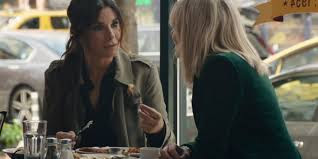
Bullock sets the tone so other actors must play to her Clutch-Cargo delivery where her face seems frozen with botox. Bullock’s bright moments include a Heidi Klum impersonation in German for stalling the museum guards while Blanchett and friends do the wet work. Viewers noticed that the women had to call in a guy, Shaobo Qin as Yen, the acrobatic “grease man” from the Oceans movies, for the actual heist.
Racial diversity is observed with a hacker (Rhianna), a pickpocket (Awkwafina), and a jewelry maker (Mindy Kaling) rounding out the team. Rhianna has several good moments injecting street humor into the stabilizing shop-lifting worldview of Bullock. Only Anne Hathaway gets to act out as the spoiled movie star and supposed mark for their highly convoluted sting to steal a six-pound diamond necklace called the Toussaint at the Met Gala.
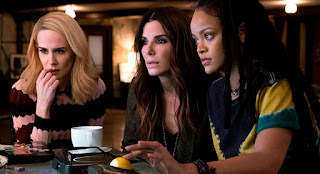
Habit patterns are believable for real women, not apeing the men, or trying to appeal to the men, but pursuing their own interests. Characters live close to the street in NYC so that visiting the fence living in the suburbs (Sarah Paulson), the only happily married character who regularly lies to her daughter about her profession, has the same feel that visiting the suburbs always has.
Spectacle is provided especially for entrances and exits in ball gowns borrowed from Vogue, cameos for aging actresses like Marlo Thomas, and tongue-in-cheek jibes (“the ego has landed”) at the cork-screwed ex-lover played by Richard Armitage. I especially liked Paulson’s infiltration of Anna Wintour’s Vogue operation that managed the Met Gala. The world belongs to women who know how to dress.
Back to Helena Bonham Carter whose dialogue is bright, especially for the bits they throw her way. (“I sweat.”) Carter out-acts Bullock and Blanchett in her first scene as an over-the-hill designer deeply in debt to the IRS. She uses an Irish accent and excellent comic timing in her scene to view the six-pound necklace at Cartier, carrying the plot without having to explain it.
Of course, the story has a big hole in the plot. The fake for the stolen necklace is re-evaluated by Cartier on its return to the vault, prompting the story’s third act about getting away with it. However, the other zircon pieces are not re-evaluated upon return and found to be fakes?
All-in-all, a satisfying chick film that can be watched more than once, if only to savor Carter’s acting skill. Also, Rhianna may have a future in movies. I’m looking forward to several sequels.

March 21, 2022
Hollywood (Still) Doesn’t Get It
Hollywood has granted quality roles to women more frequently in the new century. Many well-written characters are for a TV series such as Little Big Lies, but we have learned to not complain.
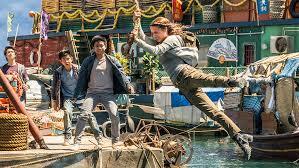
In this decade of movie remakes and gender adjustments, the reboot of Lara Croft: Tomb Raider was inevitable, I suppose. Director Roar Uthang moves from developing video games to movies with this outing, so the action sequences are in place.
The race to recover her pack stolen by a wharf street gang allowed a very buff Alicia Vikander (Light Between the Oceans) as Lara to depend on her wits and using some Captain Jack Sparrow jumps with wharf equipment. I especially enjoyed the later sequence for the rotting Japanese bomber that tumbles down the waterfall in a series of responses to Lara’s weight.
Upon analysis, though, my hackles are raised for underlying gender assumption typical of Hollywood archetypes.
Lara’s father (played by Dominic West) has a Stark-like business empire but leaves Lara isolated on the family estate with no business training or martial arts training from a misguided need to protect her. Completely isolated, Lara is forced into a pattern of self-taught skills and chip-on-her-shoulder self-reliance.
Hello, Hollywood! A son in this situation would be trained for an executive position as the heir apparent. His skills training would include Asian masters and ex-military types on daddy’s payroll.
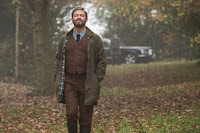
**spoiler alert**
So Daddy has gone missing, but Lara in her pride doesn’t sign into access to his billions but hones her skills as an East London bike courier. The visual transition from born-to-the-manor supposed shrinking violet to spunky street kid is painful to watch. Lara even pawns her only jewelry, a gift from Daddy, to finance the travel to Asia and her first real adventure.
My complaint is always the same. Where are Lara’s sisters and cousins and aunts and sorority sisters and rich girlfriends who have entered the university or business or the stock market? Where is the aging mentor who happens to be the Asian ambassador’s wife? A good ol’ boy support system exists for the male comic book heroes, but not for Lara Croft.

It’s true that Batman had an aging mansion and inherited wealth. It’s true that Indiana Jones went on at least one adventure following the clues left by his dad. Except both (originally cartoon) characters had a battery of colleagues from the police, university, adventurer sidekicks, foreign traders, foreign laborers — all old pals who came running with a single phone call.
Lara Croft doesn’t even have a girlfriend travel agent who will spot her the cost of a ticket to the vicinity of the exotic island. The girlfriends are kickboxers whose roles in the story are to find some excuse for a woman’s lack of upper body strength.
The only other woman in the whole movie is an executive secretary type who holds the keys to the vault, played by Kristen Scott Thomas. Her moves are mostly held in reserve because she’s set up as a possible internal nemesis in a sequel, maybe similar to the Jeff Bridges character in one of the Tony Stark movies.
I have several gripes about the storyline once Lara is in Asia, especially the useless and drunken Asian sidekick who is pressed into a work gang as soon as they arrive on the island. No diversity insult there.
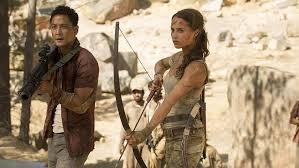
Once they open the tomb, Lara is pushed forward by Daddy and the team of bad guy diggers to lead with solving the tunnel traps, maybe as a sacrifice to them. She is allowed the mental exercise of addressing ancient puzzles from archeological evidence. When the walls begin to collapse, though, Lara can save only herself. She doesn’t save Daddy. She doesn’t save any member of the digging team. She doesn’t save the Asian workers who turn out to be good with guns once they get their hands on some.
At the end the adventure, Lara has not gained a battery of loyal followers, men or women. Her success is achieved in complete isolation.
Women action adventure heroes often operate in isolation. Who can forget Sigourney Weaver’s Ripley in Alien who must fight the monster with only the ship’s equipment as her ally? Women characters in real situations often are forced to side-step gender isolation like Jodie Foster’s Clarice Starling in Silence of the Lambs.
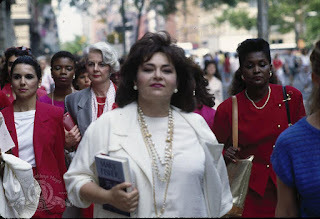
Where are their sisters or aunts or cousins or sorority sisters or trained colleagues in a good ol’ girl network?
Here’s an insight for Hollywood. Women mostly look to each other for how to solve today’s problem. Movies that allow the display of this minion are often revenge-on-husbands storylines like Rosanne Barr’s She Devil or Goldie Hawn’s First Wives Club. At least these adventures got it right for who women call first to get it done.
But I’m in danger of sounding like a problematic woman here with my ideas for improving the Lara Croft story. Next outing will be my complaints for women acting how men think women act in Oceans 8.
November 4, 2012
Killing the Undead
What is the fascination Americans have with the undead? Vampires and zombies and wrights (read GRR Martin) and werewolves and immortal enemies of Asgaard fill our screen with increasing levels of gore and violence. Even Abraham Lincoln must address bloodlusty creatures before he can rid the country of the bonds of slavery. There’s some spillover too. Regular people in a post-apocalyptic world must be destroyed. Who saw Book of Eli?
My class of college freshmen chose the undead and comic superheroes for film reviews. There was no essay on Jane Ayre or Bowling for Columbine or even The Notebook. Presentations in class fell on Halloween, I grant, but that date was coincidental.
Students wer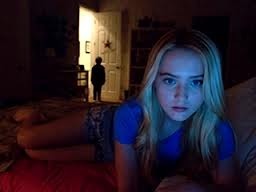 e invested in the series The Walking Dead or Paranormal activity and followed the characters as they also follow the Kardashian sisters. On, no. Oh, no, no, no, no. Most likely, there’s a movie in the works where Kim and sisters are vampires -- maybe good vampires ridding the world of dallying sports stars! LOL!
e invested in the series The Walking Dead or Paranormal activity and followed the characters as they also follow the Kardashian sisters. On, no. Oh, no, no, no, no. Most likely, there’s a movie in the works where Kim and sisters are vampires -- maybe good vampires ridding the world of dallying sports stars! LOL!
So I chewed on this issue of our fascination with the undead in movies and on TV. I have a working hypothesis. The world has shrunk and our post-WWII military-industrial complex is too big for the size of our enemies. We cannot fire the big guns after the murder of an ambassador because we need the country that harbors the terrorists as friends with oil benefits.
There’s no longer a need for a beach head and heroism under fire and strategic deployment of aircraft carriers except to aid New Yorkers who need gasoline so they can shovel sand out of houses with no electricity. We are no longer the world’s police, but rather the world’s primary caregiver.
The new normal poses a specific problem for moviemakers. How to show acts of heroism when the enemy is an illiterate unemployed gun-nut, probably a virgin, riled up by religious leaders hiding their own failures to the community, fresh from a training camp where he just learned how to fire shoulder-mounted grenades?
 From Here to Eternity was on cable last weekend. Burt Lancaster grabs the machine gun that is meant for a tripod mount and fires at overhead Japanese planes attacking Pearl Harbor. A grimace of determination, muscles taut, and no jiggling fat on his perfect torso. I got vapors of Arnold or Sly or Jason or Vin firing the big guns to save comrades and set the world straight. Except we aren’t fighting overwhelming forces anymore. We bow to oil sheiks and bow again to Chinese financiers, and laud a new socialism at the Nobel Prize ceremony.
From Here to Eternity was on cable last weekend. Burt Lancaster grabs the machine gun that is meant for a tripod mount and fires at overhead Japanese planes attacking Pearl Harbor. A grimace of determination, muscles taut, and no jiggling fat on his perfect torso. I got vapors of Arnold or Sly or Jason or Vin firing the big guns to save comrades and set the world straight. Except we aren’t fighting overwhelming forces anymore. We bow to oil sheiks and bow again to Chinese financiers, and laud a new socialism at the Nobel Prize ceremony.
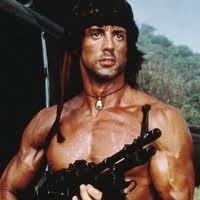 The world was shrinking while Stallone completed a series of Rambo movies. First, he displayed misplaced aggression in a narrow-minded southern town which, if not politically correct, was forgivable. In the second movie Rambo returned to Indochina to rescue soldiers who were left behind. Later he journeyed to a vaguely drawn Middle Eastern country – maybe Caucasus that nobody knows where it is – to rescue his one trusted friend. The bad guys in this series kept changing because the world had changed. We’re now friends with Cambodia and former Soviet satellite countries. Our movies must reflect the parity of competing with emerging countries for scarce resources.
The world was shrinking while Stallone completed a series of Rambo movies. First, he displayed misplaced aggression in a narrow-minded southern town which, if not politically correct, was forgivable. In the second movie Rambo returned to Indochina to rescue soldiers who were left behind. Later he journeyed to a vaguely drawn Middle Eastern country – maybe Caucasus that nobody knows where it is – to rescue his one trusted friend. The bad guys in this series kept changing because the world had changed. We’re now friends with Cambodia and former Soviet satellite countries. Our movies must reflect the parity of competing with emerging countries for scarce resources.
So the movies turned to the undead because the hero can kill large numbers of them without compunction. Heroism survives. Sword fights, up-close decapitation, men on fire, general maiming and severing of limbs, destruction of the evil installation. The hero can prove his worth to the community if he kills zombies and wrights.
And orcs. In LOTR the castle lord and small band of heroes mount horses to exit the castle and take the fight to the sea of orcs who are breaking down the walls of the keep. Our heroes ride down a ramp into the overwhelming odds of enemy forces, and some orcs fall off the ramp from the crowding. Viewers don’t think, “It’s a shame that orc with the misshapen skull had to die. He only wanted what’s best for his family.” They’re orcs; they have no souls.
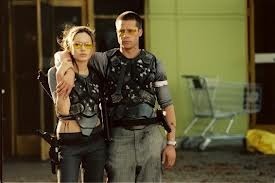 Take the problem of Mr. and Mrs. Smith where Brad Pitt and Angelina Jolie work for opposing government agencies. A contract is taken out to kill them both, god knows why, so they run and fight an unrelenting force of contract killers. Except the enemy here are supposedly real Americans working for the government. The filmmakers resolved this problem of killing large numbers of our own kind by suiting the agents with black helmets like motorcyclists wear. We don’t care if they die: we didn’t know them.
Take the problem of Mr. and Mrs. Smith where Brad Pitt and Angelina Jolie work for opposing government agencies. A contract is taken out to kill them both, god knows why, so they run and fight an unrelenting force of contract killers. Except the enemy here are supposedly real Americans working for the government. The filmmakers resolved this problem of killing large numbers of our own kind by suiting the agents with black helmets like motorcyclists wear. We don’t care if they die: we didn’t know them.
And how does a college freshman absorb this turnabout in American movies where the heroes are preserved, but the bad guys must morph into an alien force (think Prometheus) with no redeeming value?
I tried to start a discussion in class about the difference between Tony Stark and Captain America in The Avengers. Captain America was a product of government engineering and kept to a narrow moral code of leadership and duty in adversity. Tony Stark didn’t recognize the imperatives of duty and sacrifice. He was busy playing games of one-upmanship with rival corporate CEOs – self-centered and reveling in gadgets and strategic maneuvers that trip up the other superhero on his own special power.
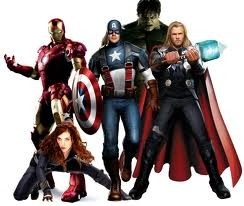 Captain America seemed stiff and stilted in the movie, adhering to a code reinforced under Truman in a time of adversity when any American could save another citizen through acts of altruism and teamwork – and annihilation of enemy cities. Except now the weapons of mass destruction must point into another galaxy so our fragile planet is not abused.
Captain America seemed stiff and stilted in the movie, adhering to a code reinforced under Truman in a time of adversity when any American could save another citizen through acts of altruism and teamwork – and annihilation of enemy cities. Except now the weapons of mass destruction must point into another galaxy so our fragile planet is not abused.
Better to kill the undead. You can kill them as many times as you want with no overtones of political incorrectness.
September 10, 2012
Uses for Magic are like Playing Chess
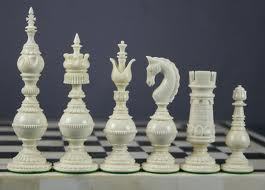 When I was a kid, my Daddy taught my brothers and me how to play chess. Only one brother excelled after the first lessons, but the introduction to the game was exhilarating, like the opportunity to make fancy moves (oh, that space is open, so I can move my knight!) and to take the opponent’s queen. What fun!
When I was a kid, my Daddy taught my brothers and me how to play chess. Only one brother excelled after the first lessons, but the introduction to the game was exhilarating, like the opportunity to make fancy moves (oh, that space is open, so I can move my knight!) and to take the opponent’s queen. What fun!
Later we learned that chess is a game of strategy and the player doesn’t move pieces without a plan. Some strategies are used many times and have names such as a fianchetto bishop or back rank checkmate. To maneuver into these board structures takes several accepted moves that your opponent will recognize with the very first move.
Magic drives the story:
Some writers are still in the learning stage (from which I never emerged as a chess player) where the intrigue rests with executing exotic moves. The purpose of writing is to explore the uses of magic.
 The (often charming) development of magic systems in these stories overwhelms the plot and serves to engage the reader on its own level – sometimes a cloying banquet of magic where the love story or the need for a final battlefield are tertiary.
The (often charming) development of magic systems in these stories overwhelms the plot and serves to engage the reader on its own level – sometimes a cloying banquet of magic where the love story or the need for a final battlefield are tertiary.
I place The Last Airbender and Percy Jackson in this category.
Magic enlivens the story:
Some writers have stepped past the stage of fun with magic and use the presence of characters with magic to drive the plot. These writers are similar to chess players who have studied some famous chess strategies and want to employ them in a match. One rule of thumb to recognize this type of writer is that the magic is similar from one series to the next – because the strategies are similar.
I place Eragon and How to Train Your Dragon in this category; formula writing using well-established plot points that delight audience expectation. But we know the outcome by page 60 because we know the strategy with the opening move.
Magic inserted just because we can:
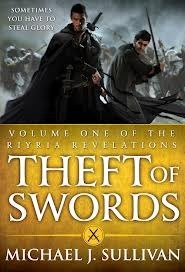 In Theft of Swords by Sullivan, an entire early sequence was about rescuing a wizard from a prison that nobody had succeeded at opening for two centuries. The descriptions were fun and the logical problems intriguing. But when the wizard is free, he says thanks and leaves. I suppose he returns later to return the favor, but I didn’t get that far.
In Theft of Swords by Sullivan, an entire early sequence was about rescuing a wizard from a prison that nobody had succeeded at opening for two centuries. The descriptions were fun and the logical problems intriguing. But when the wizard is free, he says thanks and leaves. I suppose he returns later to return the favor, but I didn’t get that far.
I read (part of) Throne of the Crescent Moon due to a recommendation from Kirkus Reviews. I suppose the readers at Kirkus are jaded and liked the story because the setting, and therefore the magic, was oriental. But the magic was everywhere, in every scene used by every character. I couldn’t follow the story – but I also couldn’t follow Battlestar Gallactica, so go figure.
Magic provides a strong ending:
The duel with the basilisk in one of the Harry Potter books is an example of overcoming the raging opponent, after which all questions are settled and Harry can return to Hogwarts for the next term with a fresh slate. And the final duel with Lord Voldemort that winds up the series is a great example of using magic to bring all influences to a conclusion.
 Magic is often tamped down in this type of story by the limitations of the user, but serves as deus ex machina in the story climax or end of a trilogy. I enjoyed The Daughter of the Forest trilogy by Juliet Marillier and cried for the last 60 pages of the first story – something about swans and sacrifice to end a curse.
Magic is often tamped down in this type of story by the limitations of the user, but serves as deus ex machina in the story climax or end of a trilogy. I enjoyed The Daughter of the Forest trilogy by Juliet Marillier and cried for the last 60 pages of the first story – something about swans and sacrifice to end a curse.
Marillier’s novels included elements of formula, though, just like with chess moves. A ingénue who is touch by magic but ignorant of its uses, guided by a would-be lover with unwavering devotion, an unrelenting female opponent, along with benign spirits and druids with little to do. Sound familiar?
The third story titled Child of Prophecy repeats these elements for a third generation while the milieu remains static. The climax is a battlefield, of course, where our ingénue enters without a plan, without her magic, and without a weapon, encouraged by spirits to “fake it”. Of course, the gods have a place for her that is not hinted at earlier in the trilogy (that I won’t reveal here), and the gods make all the combatants awestruck while our heroine performs her final farewells to family.
Magic is used sparingly or when necessary:
Some writers use magic to change the story rather than to bolster the story, a subtle difference. I enjoyed reading The Bone Doll’s Twin by Lynn Flewelling, especially the first story that sets up the curse – much like Snow White except the agent of the curse is helpful rather than mean. The reversal of the curse came (close to) the middle of the trilogy and included gender questions for girls-with-swords, so I was intrigued.
 The final story Hidden Warrior has an inserted holy man from a different culture who happens along the road at an opportune moment to serve the hero, but he wanders off before the final battle. Once the initial curse was alleviated, the presence of magic was not essential, so the inserted holy man was a maneuver (like in chess) where the reader can see the rationale.
The final story Hidden Warrior has an inserted holy man from a different culture who happens along the road at an opportune moment to serve the hero, but he wanders off before the final battle. Once the initial curse was alleviated, the presence of magic was not essential, so the inserted holy man was a maneuver (like in chess) where the reader can see the rationale.
Magic as a developed system:
Brandon Sanderson: ‘nuff said.
The only issue I have with the entire story depending on uses of magic by good guys and bad guys, that Sanderson calls “hard magic”, is that the story becomes predictable, even repetitive. The characters are dependent on skills or discipline to save them and have few other interests.
The Fantastic Four fits this category. Even the bad guy has a power, but must use it in certain ways with specific limitations. The plot revolves around how to trip him up on his own special power.
Magic from a master:
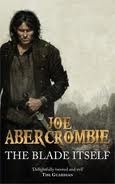 I’m currently reading The Blade Itself (Book I of a trilogy), which is long. Joe Abercrombie uses magic to build the plot and keep the reader engaged. His scenes are episodic (irritating), and too involved with the details of torture (revolting), but the reader feels the cold rain and sword cuts (shows good choices).
I’m currently reading The Blade Itself (Book I of a trilogy), which is long. Joe Abercrombie uses magic to build the plot and keep the reader engaged. His scenes are episodic (irritating), and too involved with the details of torture (revolting), but the reader feels the cold rain and sword cuts (shows good choices).
Magic is used at surprising moments and differently than a rehash for training dragons. A campfire has a spirit that our hero can tamp under his tongue to light the next campfire: he, he, he. I’m not but 48% through the book (did I mention that it’s long?), but I have hope that this chess match begins a new strategy that has yet to be named.
September 6, 2012
On Writing a Fantasy Series
Part I of a stumbling series of blogs about the trials of grappling with writing a fantasy series...
Wrap up story in first book:
Here’s my experience… I wrote the first story for SufferStone in the 1990’s without a thought that the “planet story” may grow into a series. The action of the first book comes to a conclusion and all loose ends are tucked in at the denouement.
 I should have thought ahead and allowed a bad guy to escape as George Lucas did in Star Wars when Darth Vadar survived the destruction of the Death Star. This villain returns to trouble the rebel forces in a later story.
I should have thought ahead and allowed a bad guy to escape as George Lucas did in Star Wars when Darth Vadar survived the destruction of the Death Star. This villain returns to trouble the rebel forces in a later story.
The urge to satisfy reader interest in Book I is difficult to resist. Take, for example, Kushiel’s Dart by Jacqueline Carey. Phedre is a servant of Naamah that places a high value on a tattoo along the servant’s back. She is loved and guarded by a Cassiline brother named Joscelin. When the Book I wraps up, she has inherited an estate and can ease into motherhood, except how does that whet the reader’s appetite for Book II? The last chapters actually push Joscelin away so our young heroine is available for new adventures.
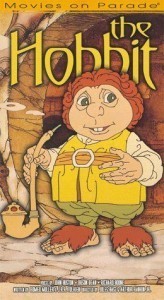 By way of comparison, JRR Tolkien wrote The Hobbit as a stand-alone novel and embarked on the LOTR series only after the success of the first book.
By way of comparison, JRR Tolkien wrote The Hobbit as a stand-alone novel and embarked on the LOTR series only after the success of the first book.
Wrap up story over three books:
So I got started with Book II titled HeartStone and pushed the story into the next generation, following characters who were children of the main characters in Book I. Favorite locations were revisited; the vocabulary grew with terms that held leitmotifs; and pressures on the residents of Dolvia were similar -- so part of my work as a writer became familiar, like greeting an old friend.
I also had big themes I was pursuing such as how do women solve problems within a segregated community, and how do the tribes bind together to become an emerging nation.
The second book became part of a story arch that, I thought, would be resolved over three books as Brianna Miller is introduced as a teenager and grows into a capable businesswoman and politician for her tribe. Good plan, huh?
What happened to me was that a section of Book III titled StrikeStone blossomed into its own story line with a new narrator who I could not resist, so the plan to “wrap up” the story in three books is abused. I’m so grateful for the series of six or twelve books from other writers so I’m not a pathfinder for returning to Dolvia for a new go-around with familiar characters.
I wonder if you (as a writer) had similar experiences where the characters take you to (delicious) places you had not imagined months earlier?
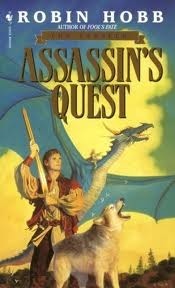 For example, Robin Hobb wrote the Farseer series, followed by the Liveship series. I could see hints that she would combine the two because the worlds were similar enough to become tangent. The Farseer series mentions stone dragons and memory stones, but real dragons are introduced later as part of the reader learning more about the milieu.
For example, Robin Hobb wrote the Farseer series, followed by the Liveship series. I could see hints that she would combine the two because the worlds were similar enough to become tangent. The Farseer series mentions stone dragons and memory stones, but real dragons are introduced later as part of the reader learning more about the milieu.
Keep the characters alive for a series without becoming formula:
I enjoyed The Bone Doll’s Twin by Lynn Flewelling, but the mystery of the twins is resolved in Book III before a final battle scene that ties up all story lines, so I cannot imagine why she would begin again with this characters. Maybe she has already moved onto developing a new milieu.
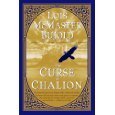 In The Curse of Chalion by Lois MacMasters Bujold, the ingénue Iselle wins her true love and plot points are tucked in nicely after the bad guy dies. The following book Palladin of Souls follows the adventures of tangent characters so that Iselle who became a ruler of the kingdom, and Caz, the narrator of Book I, are only mentioned in the later stories. Bujold has a tendency to provide character studies within an otherworld with several planets (or castles) and several tangent sets of characters rather than the growth of one hero/heroine during a war or regime change.
In The Curse of Chalion by Lois MacMasters Bujold, the ingénue Iselle wins her true love and plot points are tucked in nicely after the bad guy dies. The following book Palladin of Souls follows the adventures of tangent characters so that Iselle who became a ruler of the kingdom, and Caz, the narrator of Book I, are only mentioned in the later stories. Bujold has a tendency to provide character studies within an otherworld with several planets (or castles) and several tangent sets of characters rather than the growth of one hero/heroine during a war or regime change.
So the arch of a series in fantasy is dictated more by character growth and changing action than by a formula the writer has sketched out in advance. My question today concerns controlling elements of the story and what experiments from writers seemed to work, and which ones may have been less effective.
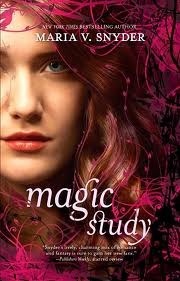 In Magic Study, I think it was, Book III of a series by Maria Snyder, the main characters travel over a mountain pass to speak with a sibyl and meet a new tribe who happen to show miniature dragons as a curio, much like the baby dragons in (which one, Book V??) of Harry Potter that never re-enter the story. Here are fantasy elements that titillates but are left undeveloped.
In Magic Study, I think it was, Book III of a series by Maria Snyder, the main characters travel over a mountain pass to speak with a sibyl and meet a new tribe who happen to show miniature dragons as a curio, much like the baby dragons in (which one, Book V??) of Harry Potter that never re-enter the story. Here are fantasy elements that titillates but are left undeveloped.
What are your experiences with writing/reading fantasy series? Which ones lacked the magic? Which ones were overloaded with fantasy elements?
September 4, 2012
Self-Publishers: Process Frustration
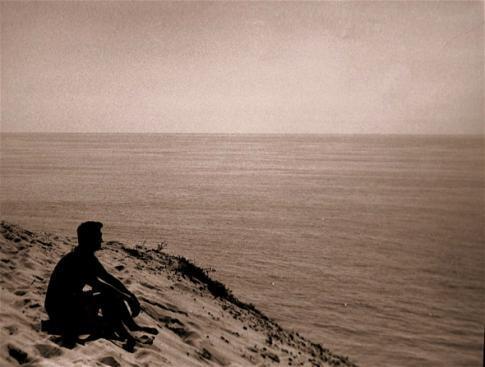 So I finished a sustained writing effort and felt euphoria from working consistently with characters and scenes. (200 pages! Yeah!) I wanted to share my elation and found my artist friend to explain what I had accomplished. He said, “I’m glad you finished your piece.” And that was it.
So I finished a sustained writing effort and felt euphoria from working consistently with characters and scenes. (200 pages! Yeah!) I wanted to share my elation and found my artist friend to explain what I had accomplished. He said, “I’m glad you finished your piece.” And that was it.Later he caught up with me and wanted to expand his response. “It’s just that I have not read the book, and I don’t know what you mean.” I told him my theory about process frustration that all artists feel, but novelists feel in spades.
 Signs of Process Frustration:
Signs of Process Frustration:1) Did you ever talk for hours about your characters or themes to complete strangers?
2) After expressing you ideas about where you are in the project, did you find that you no longer have the creative energy to write?
3) Did you ever wear out family members describing the fresh scenes so they wonder what’s in your head and why didn’t you make dinner?
4) Did you become silent and selfish about the project or characters or themes because you believe expressing the ideas dilutes them?
5) Conversely, did you ever lend chapters to a friend only to get the critique “It needs work?”
How to Manage Process Frustration:
1) Recognize it for what it is. You are engaged with characters who your friends don’t know. Why mix the two?
2) Enjoy to euphoria of completion without tying it to the work – try a walk along the beach
3) Avoid visiting the emotive quotient on friends and family.
I had a good friend once who was a big sports fan. If his team won, we went out for a meal and batting practice. If his team lost, we left him alone in the man-cave rather than try to cheer him up. During play-offs, Sunday nights could be grim.
As a writer, I have found that this kind of spill-over makes even less sense because your family cannot engage with your characters.
 Another choice is to find friends among writers and trade stories and chapters for critique. One recommended source is the fantasy writers group on Reddit. Some people swear by this process, but I have always found that my critiques are too detailed and poorly received. New writers, especially, are too sensitive for ideas for improvement.
Another choice is to find friends among writers and trade stories and chapters for critique. One recommended source is the fantasy writers group on Reddit. Some people swear by this process, but I have always found that my critiques are too detailed and poorly received. New writers, especially, are too sensitive for ideas for improvement.
So, what’s the solution? Tolerate the solitude and learn to treasure good reviews on GoodReads and LibraryThing?
 I have found that discussing craftsmanship with fellow artists, some from tangent disciplines, helps with articulating method, constraints, signals for poor choices, finding satisfaction, learning from finished products, avoiding bad critiques. The chats about craft are often conceptual rather than practical, but serve as an area where we can at least admit the pressures and face the long stretches of time spent alone.
I have found that discussing craftsmanship with fellow artists, some from tangent disciplines, helps with articulating method, constraints, signals for poor choices, finding satisfaction, learning from finished products, avoiding bad critiques. The chats about craft are often conceptual rather than practical, but serve as an area where we can at least admit the pressures and face the long stretches of time spent alone.
Your turn to participate… How do you manage process frustration?
September 1, 2012
September at GoodReads
Back to school!
Explore the GoodReads pages for SufferStone: Book I of the Dolvia Saga, and for Book II titled HeartStone.
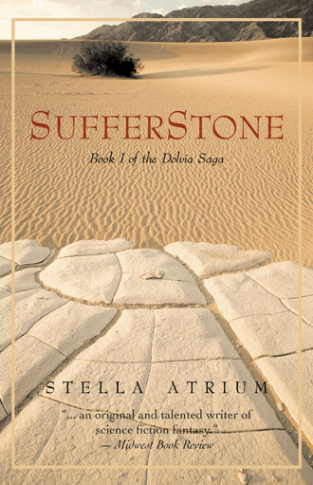 Look for giveaways of paperback copies. Two weeks only!
Look for giveaways of paperback copies. Two weeks only!
http://www.goodreads.com/giveaway/sho...
http://www.goodreads.com/giveaway/sho...
More blogs to come... (been writing Book IV all summer)



